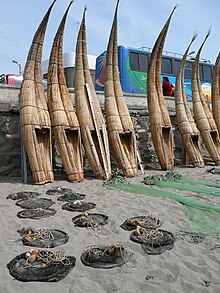Reed boat
They were also constructed from early times in Peru and Bolivia, and boats with remarkably similar design have been found in Easter Island and also New Zealand where they were made by indigenous Māori.
The explorations and investigations of the Norwegian ethnographer and adventurer Thor Heyerdahl have resulted in a better understanding of the construction and capabilities of reed boats.
The reed boat is similar to those depicted in cave paintings in Scandinavia, something that led Thor Heyerdahl to theorise that the Scandinavians came from the area that today is Azerbaijan.
[5] Theophrastus in his History of Plants[6] states that the rigging on King Antigonus' fleet, used to fasten the doors when Ulysses slew the suitors in his hall,[7] was made from papyrus reed.
[5] According to the Bible, when the Pharaoh issued a decree to kill all the Israelite males, the baby Moses was saved by his mother, who set him adrift on the Nile in an ark of bulrushes.
In more recent years, the explorations and investigations of the Norwegian ethnographer and adventurer Thor Heyerdahl, 1914–2002, have resulted in a better appreciation of the construction and capabilities of reed boats.
Heyerdahl wanted to demonstrate that ancient Mediterranean or African people could have crossed the Atlantic and reached the Americas by sailing with the Canary Current.
The purpose of building this vessel was to demonstrate that Mesopotamia could have been linked through trade and migration to the Indus Valley civilization, now modern-day Pakistan.
[11] Reed boat craftsmen from Suriqui, a town on the Bolivian side of lake Titicaca, helped Thor Heyerdahl construct Ra II and Tigris.
[13] Green andesite stones, that were used to create elaborate carvings and monoliths, originated from the Copacabana peninsula, located across Lake Titicaca.
[14] One theory is that these giant andesite stones, which weigh over 40 tons were transported some 90 kilometres across Lake Titicaca on reed boats.





